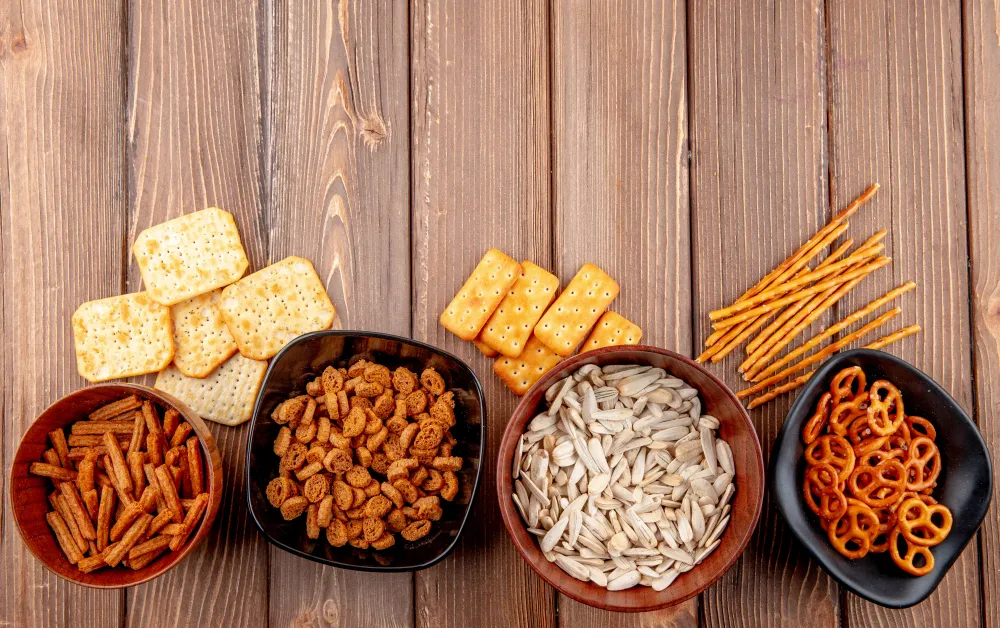Thinking of starting your own snacks brand?
The snacks market is massive, fast-moving, and full of opportunities. If you have a unique idea or product, you're already one step ahead. But before you jump into packaging and promotions, you need to understand your market.
At Consainights, we’ve helped hundreds of businesses validate their product ideas, size their market, and identify the right audience. In this guide, we’ll walk you through a clear and practical approach to doing market research for your snacks brand—so you build something people actually want to eat.
What Needs to Be There in the Market Research
Different industries require different types of insights when it comes to market research. For a snacks brand, it's not just about knowing the competition—it's about understanding consumer behaviour, price expectations, packaging preferences, and distribution trends.
We’ll use a fictional snacks brand named "Crunchora" – a millet-based, baked snack targeting health-conscious urban millennials. Here are the key elements your market research should include to give you a strong foundation before launch.
1. Target Audience Analysis
Before Crunchora launched, the team needed to define who they were selling to. They didn’t say "everyone who likes snacks." Instead, they focused on:
- Demographics: 22–35-year-old working professionals in metro cities like Bangalore, Mumbai, and Delhi.
- Lifestyle Traits: Fitness-focused, health-aware, label readers, often shop online.
- Pain Points: Bored with regular chips, want a healthier option without compromising taste.
Insight: Market research should involve surveys, interviews, and even small in-store observation studies to understand what your audience is currently buying and why. Crunchora ran Instagram polls and short Google surveys to validate that “millet” as a base was both trendy and acceptable.
2. Competitor Mapping
Crunchora’s team studied direct competitors like Too Yumm!, TagZ, and The Whole Truth. But they also looked at indirect ones—like traditional namkeen brands or energy bars.
Key things they analysed:
- Price Range: ₹30–₹50 per pack for 40g
- USP: Air-baked, high protein, low-fat
- Packaging: Bold, colourful, with health stats visible on the front
Insight: Don’t just look at what your competitors say—check what consumers are actually liking. Crunchora did this by analysing Amazon reviews and looking at social media engagement for snack brands.
3. Market Size and Demand Trends
Crunchora found that the Indian healthy snacks market was growing at over 20% CAGR and projected to reach ₹30,000 crore in the next 5 years.
They also explored:
- Snack frequency in urban households (2–3 times a day)
- Search trends using tools like Google Trends (e.g. "healthy snacks for office" spiking post-COVID)
- Retailer feedback from local organic stores
Insight: Estimating demand helps you decide whether to start small (online D2C) or aim for retail distribution from day one.
4. Taste Preferences and Product Testing
Crunchora did 3 rounds of blind taste testing before finalising their flavour lineup.
What they learned:
- Indian consumers like fusion flavours—Peri Peri Millet was a hit, but Cheesy Spinach didn’t do well
- Texture matters: baked snacks must still feel "crunchy" to match expectations set by fried ones
- Kids liked the mild flavours, but parents wanted added protein and fibre
Insight: Always run controlled testing with different groups. Don’t just trust your own taste. Crunchora invited fitness club members, college students, and homemakers for test rounds.
5. Price Sensitivity and Willingness to Pay
Crunchora tested two price points—₹30 and ₹45. The ₹45 version had premium packaging and more nutrients.
Findings:
- Online buyers were okay paying ₹45 if shipping was free
- Supermarket shoppers compared it to Lays and preferred ₹30
- Subscription-based buyers were open to ₹40 if bundled with monthly offers
Insight: Always test multiple price points. Your audience may accept a premium—if they feel it is justified.
6. Packaging and Shelf Appeal
They tested 3 different designs using a simple mockup test on Instagram Stories. The pack with vibrant colours and bold flavour labels won by far.
Key factors:
- Window pouches were less preferred than metallic packs
- Consumers cared about resealability
- "Gluten-free" and "No Palm Oil" had strong recall value
Insight: Great product inside bad packaging = no sales. Invest in A/B testing even before you print in bulk.
How to Do the Market Research for Your Snacks Brand?
Now that you know what elements your market research should cover, it’s time to get to work. Market research isn’t just about reading reports—it’s about collecting real-world data that helps you make better decisions.
Here are the key steps you need to follow, along with tools, examples, and actions to get started:
1. Define Your Customer Persona
Start by answering: Who are you selling to?
Build a clear profile of your ideal customer with fields like:
- Age range
- Location
- Diet habits (e.g. vegan, gluten-free)
- Snack buying frequency
- Where they shop (online/offline)
- What flavours or formats they prefer
Example: Crunchora targeted 25–35-year-old fitness-conscious professionals living in Tier 1 cities who prefer clean-label snacks.
Tools to use:
- Google Forms for surveys
- Typeform for interactive questionnaires
- Instagram Polls for rapid feedback
2. Study Competitors In-Depth
Look beyond the brand—understand the full customer journey.
Research these fields for each competitor:
- Product category and USP
- Price range
- Packaging and shelf design
- Website and D2C journey
- Amazon or BigBasket reviews
- Social media strategy
Example: Crunchora reviewed TagZ’s Amazon reviews to see complaints around small pack size and replicated none of that in their offering.
3. Validate the Product Idea Through Real Feedback
Before mass production, test your idea with 100–200 real users.
Ways to do this:
- Run a pop-up stall at a flea market
- Distribute free samples at gyms, offices, or campuses
- Offer a "beta box" of 3 flavours for ₹99 online
4. Study Market Demand and Industry Trends
You need to know how big the opportunity really is. Research the size of the snacks market, its growth rate, and key consumer shifts. For example, millet-based snacks and low-carb options have been trending in the urban Indian segment.
Crunchora used Google Trends and research portals like Consainsights to discover that “gut-friendly snacks” and “zero-oil snacks” were gaining traction. Even free tools like Google Keyword Planner or YouTube search can give you an idea of what people are actively looking for.
5. Understand Sales Channels and Buying Preferences
Figure out where your target audience prefers to buy snacks. Online (D2C, Amazon, BigBasket)? Local grocery stores? Gyms and cafes? For Crunchora, influencer stories and word-of-mouth via WhatsApp brought early traction.
They realised their buyers were more active online and preferred subscription packs. Tools like Meta Ads Manager and Shopify helped them test audience segments and measure sales sources. Start small with one focused channel and test results before expanding.
Here are some major sales channels that you can study about:
| Sales Channel | Examples |
|---|---|
| Modern Trade | Reliance Fresh, Big Bazaar, D-Mart, Spencer’s |
| General Trade (Kirana Stores) | Local convenience stores, neighbourhood grocery shops |
| D2C Website | Shopify store, WooCommerce site |
| Online Marketplaces | Amazon, Flipkart, BigBasket, Zepto |
| Quick Commerce Apps | Blinkit, Instamart, Zepto |
| Niche Retail (Gyms, Cafes, Organic) | Cult.fit gyms, Third Wave Coffee, Nature’s Basket |
| Corporate Gifting & Office Pantries | Startup offices, coworking pantry supply, gifting portals |
| Subscription Boxes & Bundling | Monthly snack boxes, health bundle packs |
| Events, Exhibitions & Flea Markets | Sunday Soul Sante, college fests, local trade fairs |
| Export / International Distribution | Middle East, UK, Singapore (through trade/export partners) |
Based on your needs, business model, and other factors, you can choose the most relevant sales channels.
6. Test Your Branding and Packaging
Packaging is the first thing people notice. You need to test designs before printing in bulk. Create mockups using Canva or Figma and post them on Instagram or in Reddit feedback groups.
Crunchora tested three variations—bold, minimal, and earthy. The bold one won by a clear margin in polls. Then, they printed a small batch and observed in-store reactions. Remember, good packaging isn’t just pretty—it must be functional, resealable, and clearly communicate your brand’s benefits.
Let Consainsights Help You With Custom Market Research
Market research isn’t just a one-time activity—it’s the foundation for every decision you’ll make as a brand. At Consainsights, we bring the experience of studying over 13,000 markets and helping hundreds of food and FMCG brands validate, launch, and grow with confidence.
We can help you with complete, custom market research tailored to your snacks brand. This includes identifying your ideal audience, analysing competitors, studying market size and trends, testing product concepts, and even mapping out your pricing and sales channels.
Also, if you need support with packaging design feedback, early user surveys, or testing different sales models, our team can build that into your research report. Let us do the groundwork so you can focus on building a brand people love to snack on.







